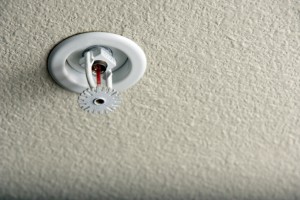Although a fire extinguisher is key to helping put out fires, it isn’t the only system that you should have on hand to protect your property. Sprinkler systems are extremely important to protecting and putting out damaging fires. But how do fire sprinkler systems work and what kind do you need for your business?
How Sprinkler Systems Work
When it comes to protecting your business, no system has your back more than a sprinkler system. When a fire starts in your business, the resulting smoke will set off the smoke alarms strategically positioned around your commercial space. When the heat from the fire rises in the air, the heat activates the sprinkler heads. But not just any heat will trigger a sprinkler system. A sprinkler head must detect a temperature between 135 to 165 degrees Fahrenheit. Sprinkler heads are equipped with a glass trigger filled with a glycerin-based liquid that expands with temperature. As the liquid expands, it breaks the glass and activated the sprinkler head. These sprinkler heads are attached to a reliable system of water pipes that are typically built into the walls or ceiling. Beneath the sprinkler heads, a valve keeps the water from leaking out. When the sprinkler head is triggered, the valve is opened and water is released from the pipes.
Wet-Pipe Sprinkler Systems
The time it takes to release the water from the sprinkler system depends on the type of system you choose for your business. There are actually four different types of sprinkler systems you can choose from. The first is the wet-pipe sprinkler system. This system is the most common sprinkler system and is simple to maintain and reliable. Wet-pipe systems store water under pressure directly in the pipes and are able to release the water immediately.
Dry-Pipe Sprinkler Systems
A dry-pipe sprinkler system has a similar design to wet-pipes with the exception of water being stored in the pipes. These pipes contain pressurized air or even nitrogen. A valve is held in a closed position that doesn’t allow water to enter the pipe unless heat activates the sprinkler. Once activated, the air escaped and the valve releases, allowing water to flow into the pipes and out the open sprinklers.
Pre-Action Sprinkler Systems
Like the dry-pipe system, the water is not stored in the pre-action sprinkler system. Instead, the water is kept from the piping by an electronically operated valve. When a fire is detected, the device opens the valve located inside the pipes to allow the water to flow out of the sprinkler system. This system contains both a double interlocking mechanism as well as the pressurized air or nitrogen. This mechanism monitors the pipes for leaks as well as holding the water away from the piping in order to prevent an accidental release.
Deluge Sprinkler Systems
A deluge system is ideal for a highly hazardous area that could contain a fuel hazard with a high rate of heat. This system is typically found near warehouse bay entries or any other place a fire could spread rapidly. The sprinkler head stays open all the time and are not activated by heat. This system is activated by a fire alarm that causes the water to release. Once open, the valve must be shut off manually. When it comes to protecting your business, there is nothing better than a sprinkler system, but which system will you choose?
Sprinkler Systems with Fireline
At Fireline, we offer an array of portable fire extinguishers, fire alarms, and sprinkler systems to keep commercial kitchens safe. Fireline offers the highest quality alarm systems to keep your business safe from fires and carbon monoxide poisoning. We also offer fire suppression systems as well to help keep commercial fires controlled should they break out. Our trained technicians will work with you to determine which air sampling smoke detection system is best for your business. We will also help install and maintain the system for your commercial building.
To get started with Fireline today, or for more information on sprinkler systems call us at 1-800-553-3405, or visit our contact page.
Be sure to “Like” and “Follow” the official Fireline page today on Google+, Facebook, Twitter, and LinkedIn.

